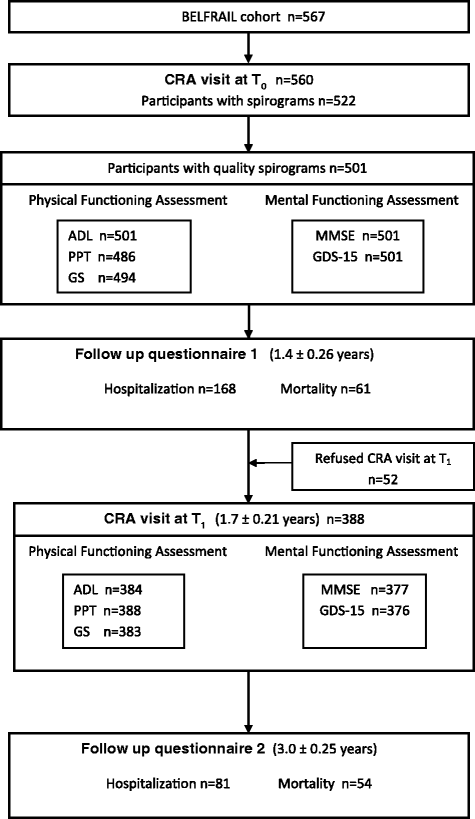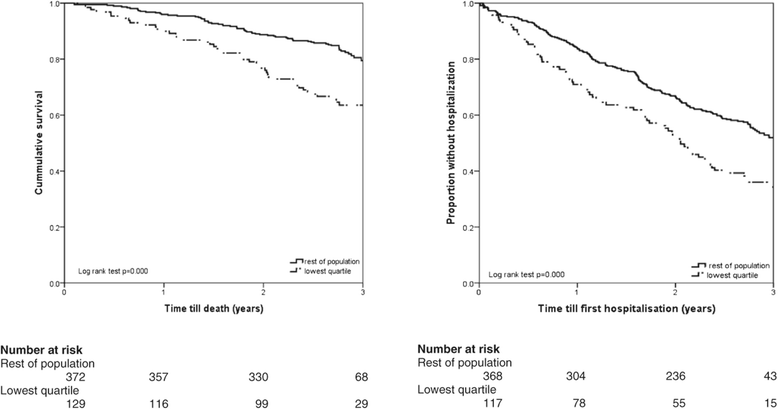Short-term prognostic value of forced expiratory volume in 1 second divided by height cubed in a prospective cohort of people 80 years and older
- PMID: 25888051
- PMCID: PMC4345023
- DOI: 10.1186/s12877-015-0013-4
Short-term prognostic value of forced expiratory volume in 1 second divided by height cubed in a prospective cohort of people 80 years and older
Abstract
Background: Spirometry-based parameters of pulmonary function such as forced expiratory volume in 1 second (FEV1) have prognostic value beyond respiratory morbidity and mortality. FEV1 divided by height cubed (FEV1/Ht(3)) has been found to be better at predicting all-cause mortality than the usual standardization as percentage of predicted "normal values" (FEV1%) and its use is independent of reference equations. Yet, limited data are available on the very old adults (80 years and older) and in association to other adverse health outcomes relevant for this age group. This study aims to investigate the short-term prognostic value of FEV1/Ht(3) for all-cause mortality, hospitalization, physical and mental decline in a cohort of very old adults.
Methods: In a population-based prospective cohort study of 501 very old adults in Belgium, comprehensive geriatric assessment and spirometry were performed at baseline and after 1.7 ± 0.21 years. Kaplan-Meier curves for 3-year all-cause mortality and hospitalization rates and multivariable analysis adjusted for age, sex, smoking status, co-morbidities, anemia, high C reactive protein and creatinine levels examined the association of FEV1/Ht(3) with all-cause mortality, unplanned hospitalization and decline in mental and physical functioning. Physical functioning was assessed by activities of daily living, a battery of physical performance tests and grip strength. Mental functioning was assessed with mini mental state examination and 15 items geriatric depression scale.
Results: Individuals in the lowest quartile of FEV1/Ht(3) had a statistically significant increased adjusted risk for all-cause mortality (hazard ratio [HR] 1.69, 95% confidence interval [CI] 1.10-2.60) and unplanned hospitalization (HR 1.65, 95% CI 1.21-2.25), as well as decline in physical (odds ratio [OR] 1.89, 95% CI 1.05-3.39) and mental functioning (OR 2.39, 95% CI 1.30-4.40) compared to the rest of the study population.
Conclusions: In a cohort of very old adults, low FEV1 expressed as FEV1/Ht(3) was found to be a short-term predictor of all-cause mortality, hospitalization and decline in physical and mental functioning independently of age, smoking status, chronic lung disease and other co-morbidities. Further research is needed on FEV1/Ht(3) as a potential risk marker for frailty and adverse health outcomes in this age group.
Figures


Similar articles
-
Prognostic value of short-term decline of forced expiratory volume in 1 s over height cubed (FEV1/Ht3) in a cohort of adults aged 80 and over.Aging Clin Exp Res. 2018 May;30(5):507-516. doi: 10.1007/s40520-017-0792-x. Epub 2017 Jun 26. Aging Clin Exp Res. 2018. PMID: 28653254
-
Predictive Value of Different Expressions of Forced Expiratory Volume in 1 Second (FEV1) for Adverse Outcomes in a Cohort of Adults Aged 80 and Older.J Am Med Dir Assoc. 2017 Feb 1;18(2):123-130. doi: 10.1016/j.jamda.2016.08.012. Epub 2016 Oct 14. J Am Med Dir Assoc. 2017. PMID: 27751804
-
Correlates of dyspnoea and its association with adverse outcomes in a cohort of adults aged 80 and over.Age Ageing. 2017 Nov 1;46(6):994-1000. doi: 10.1093/ageing/afx095. Age Ageing. 2017. PMID: 28633384
-
Lower limit of normal or FEV1/FVC < 0.70 in diagnosing COPD: an evidence-based review.Respir Med. 2011 Jun;105(6):907-15. doi: 10.1016/j.rmed.2011.01.008. Epub 2011 Feb 5. Respir Med. 2011. PMID: 21295958 Review.
-
[Prognostic indices for older adults during the year following hospitalization in an acute medical ward: An update].Presse Med. 2017 Apr;46(4):360-373. doi: 10.1016/j.lpm.2016.09.026. Epub 2017 Mar 18. Presse Med. 2017. PMID: 28325586 Review. French.
Cited by
-
An Introduction to a Head and Neck Cancer-Specific Frailty Index and Its Clinical Implications in Elderly Patients: A Prospective Observational Study Focusing on Respiratory and Swallowing Functions.Oncologist. 2016 Sep;21(9):1091-8. doi: 10.1634/theoncologist.2016-0008. Epub 2016 Jul 1. Oncologist. 2016. PMID: 27368883 Free PMC article.
-
All-cause and cardiovascular mortality in relation to lung function in the full range of distribution across four Eastern European cohorts.Sci Rep. 2022 Jul 28;12(1):12959. doi: 10.1038/s41598-022-17261-5. Sci Rep. 2022. PMID: 35902678 Free PMC article.
-
How to Stage Airflow Limitation in Stable Chronic Obstructive Pulmonary Disease Male Patients?Am J Mens Health. 2020 May-Jun;14(3):1557988320922630. doi: 10.1177/1557988320922630. Am J Mens Health. 2020. PMID: 32475199 Free PMC article.
-
Predictors of poor-quality spirometry in two cohorts of older adults in Russia and Belgium: a cross-sectional study.NPJ Prim Care Respir Med. 2015 Jul 23;25:15048. doi: 10.1038/npjpcrm.2015.48. NPJ Prim Care Respir Med. 2015. PMID: 26201999 Free PMC article.
-
An updated comparison of standard and novel FEV1 indices' association with all-cause mortality.PLoS One. 2025 May 15;20(5):e0323681. doi: 10.1371/journal.pone.0323681. eCollection 2025. PLoS One. 2025. PMID: 40373056 Free PMC article.
References
Publication types
MeSH terms
LinkOut - more resources
Full Text Sources
Other Literature Sources
Medical
Research Materials

